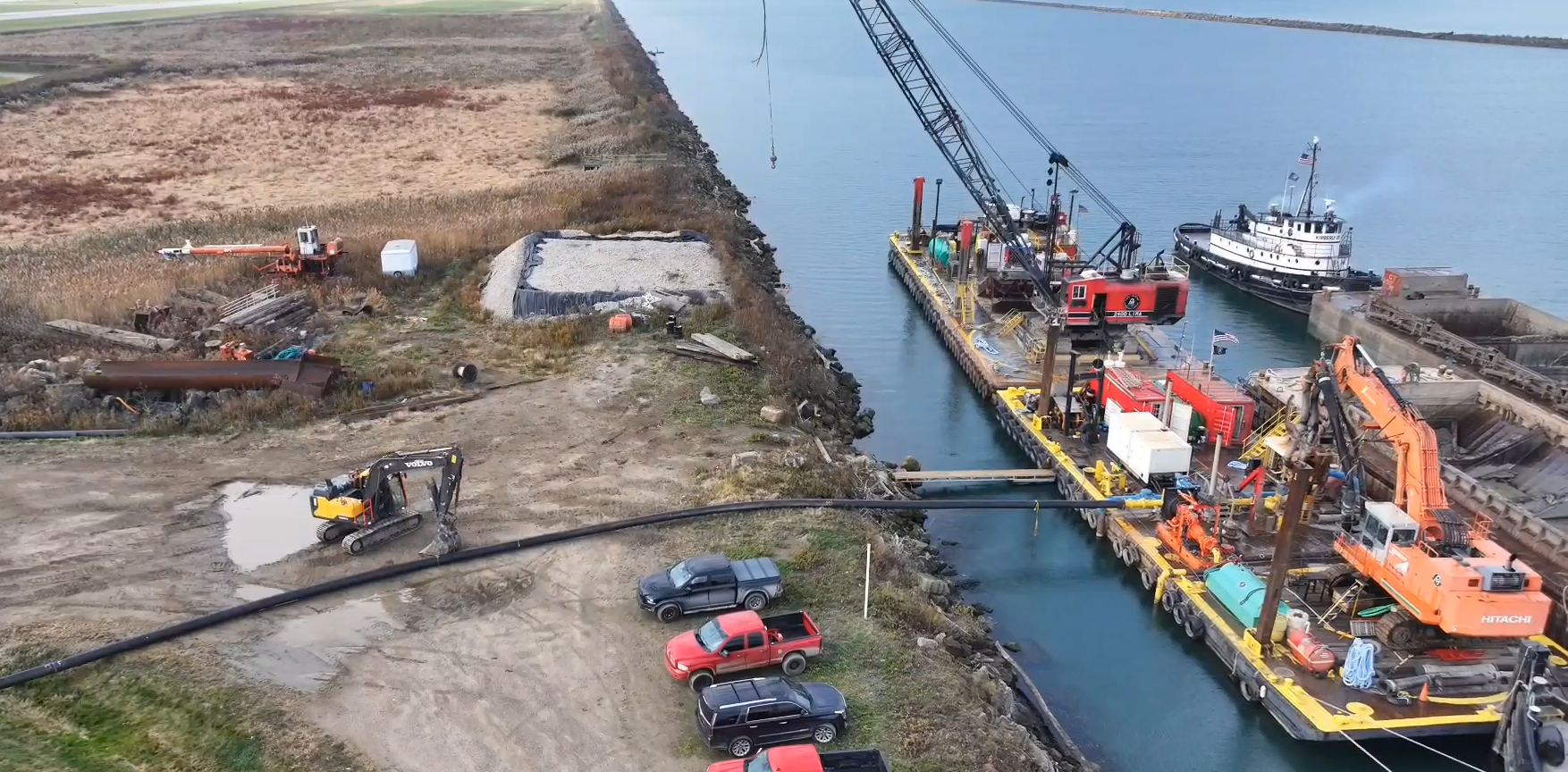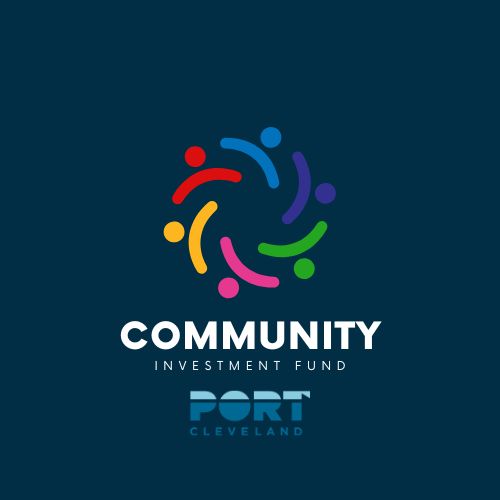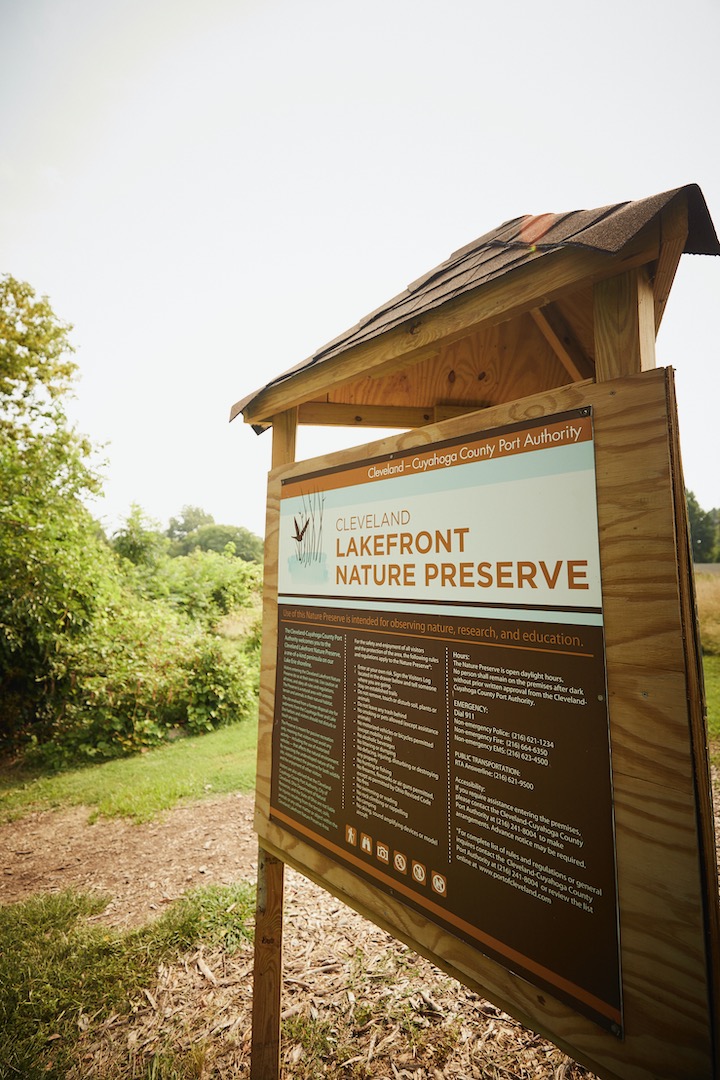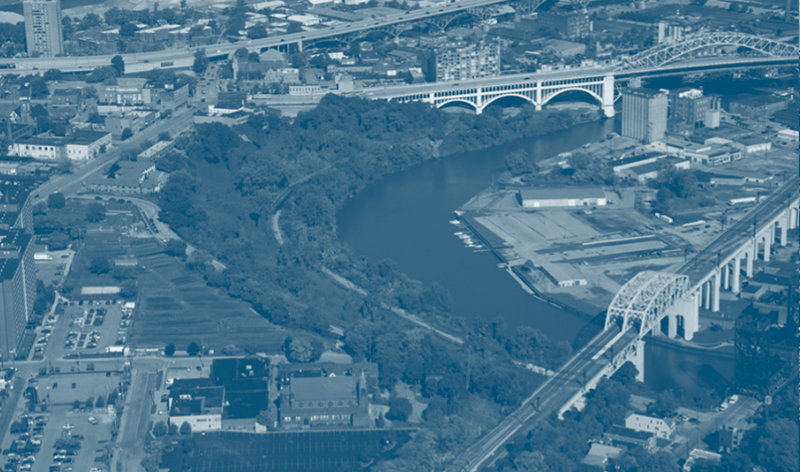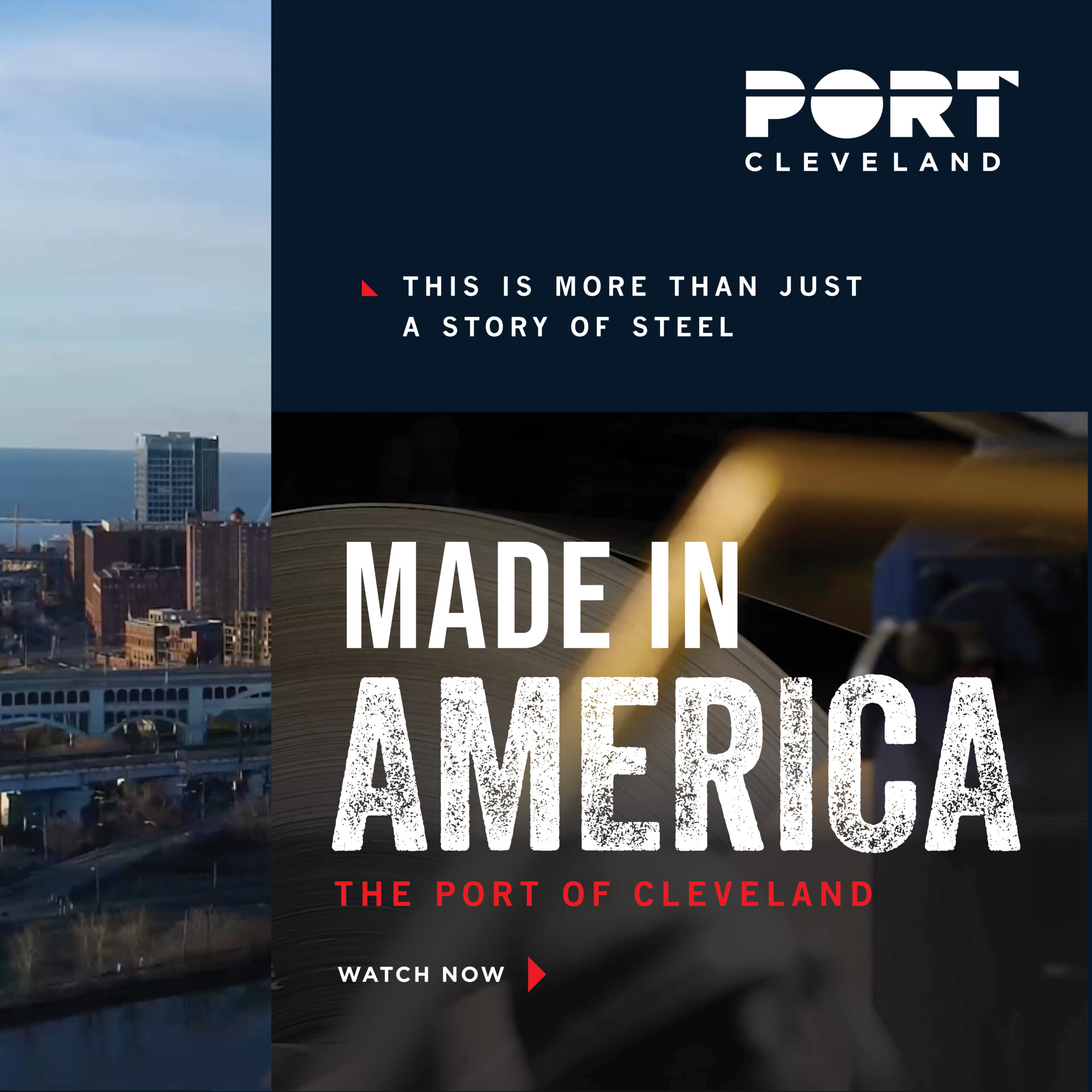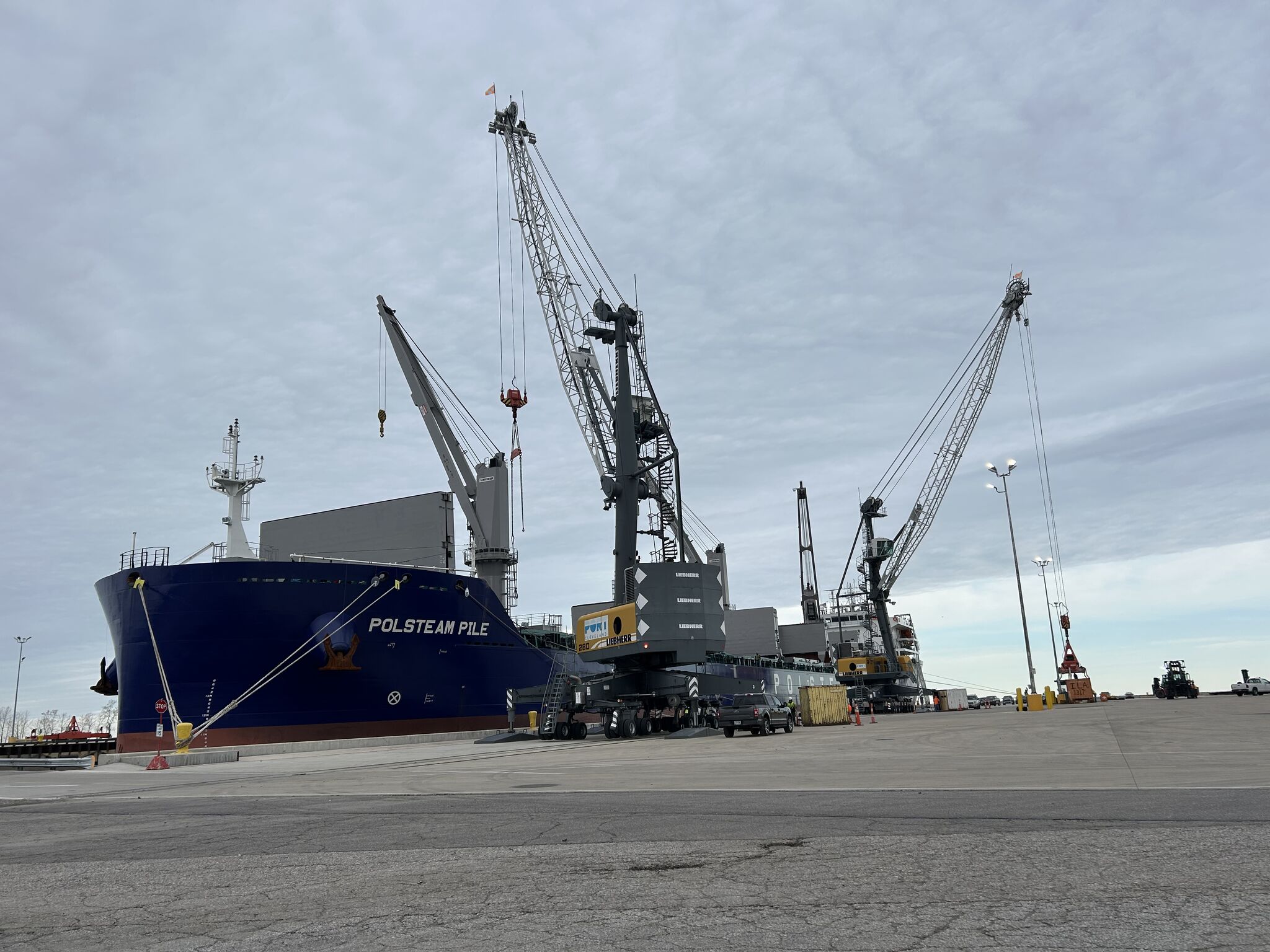Newsroom
Port board oks $4 million project to extend life of current dredge repository until CHEERS is ready
Port board oks $4 million project to extend life of current dredge repository until CHEERS is ready
CLEVELAND – July 10, 2025 – A $4 million construction contract to extend the life of the Port’s current dredge repository was approved yesterday by the Port board of directors.
The contract with Mark Haynes Construction, Inc., will extend the life of a dredge sediment repository north of Burke Lakefront Airport through 2029. The Port funding is expected to be paid back over time through tipping fees to dredging contractors, which are under contract with the U.S. Army Corps of Engineers.
The Port’s Sediment Processing and Management Facility is the only facility permitted to receive the 250,000 cubic yards of sediment dredged each year from the Cleveland Harbor and Cuyahoga River, an action which keeps shipping lanes open. At the facility, the Port beneficially harvests and recycles much of the dredge material.
Bids from two contractors were received for the work. The Mark Haynes bid was deemed the lowest responsive and responsible bid.
“This will buy us time until CHEERS is permitted and that area is ready to accept dredged sediment,” said Matt Wenham, Chief of Engineering & Capital Development at the Port.
CHEERS — the Cleveland Harbor Eastern Embayment Resilience Strategy — is, a bold initiative to reshape Cleveland’s East Side waterfront. The project will repurpose sediment dredged from the Cuyahoga River to create a resilient shoreline that protects vital infrastructure while expanding public access to Lake Erie.
Port of Cleveland Awards $260,000 in Community Investment Grants to Seven Local Nonprofits
Port of Cleveland Awards $260,000 in Community Investment Grants to Seven Local NonprofitsGrants will support maritime education, neighborhood revitalization and economic opportunity across Cuyahoga County
CLEVELAND – July 10, 2025 – The Port of Cleveland board of directors today approved the allocation of $260,000 in Community Investment Fund (CIF) grants to help support seven local organizations advancing education, historic preservation and maritime access across the community.
“These awards reflect our deep commitment to investing in people and places that shape a stronger, more inclusive future for our region,” said David Gutheil, Interim CEO of the Port of Cleveland. “Each selected project aligns with the Port’s mission to drive economic vitality while strengthening the communities we serve.”
Established in 2018, the Community Investment Fund sets aside 10% of Port development finance revenues annually to support nonprofit-led initiatives that align with the Port’s values – especially around workforce readiness, sustainability, and equitable development. To date, the fund has invested over $500,000 in community grants to community-based organizations throughout Cuyahoga County.
The Port issued a Notice of Funding Opportunity (“NOFO”) on May 15 and received 17 qualified proposals. Following an in-depth evaluation of the proposals, the CIF committee has recommended funding the following organizations for the following reasons:
Teaching Cleveland / $50,000: For the support of the refinement of our Fresh Water Institute Year 1 experience, as well as the onboarding and engagement of a new cohort of students. The Fresh Water Institute (FWI) is an interdisciplinary, two-year program designed for Northeast Ohio area high school students to delve into the critical importance of Lake Erie and the Great Lakes to our region. Through rigorous summer field research and capstone projects, fellows will develop a comprehensive understanding of the water cycle, its impact on our communities, and the complex environmental and social issues surrounding this essential resource.
· Great Lakes Science Center / $50,000: To support maritime-focused programming and operational activities for the Centennial Celebration of the Steamship William G. Mather including mobile maritime outreach and interactive Great Lakes history exhibits.
· Cleveland Restoration Society / $50,000: To recapitalize its Historic Properties Fund to enable strategic investments in Cleveland properties it currently owns or might own in the near future. These properties include eight houses on Newton Avenue (Hough neighborhood), the Dall-Mays Houses on E. 46th Street (Central neighborhood), and the Jesse Owens Family Home (Fairfax neighborhood). Investments in these properties would be transformational for the subject property and for the surrounding area.
· Cleveland Rowing Foundation / $35,000: To hire a Row Cleveland community engagement coach focused on expanding rowing and river access to underserved neighborhoods.
· Baldwin Wallace University / $30,000: To fund the “Mobile Wave Tank for Marine Technology Outreach” to design and build a demonstration scale (approximately two-meter length) wave tank for education and outreach. The key applications of this project will focus on ocean exploration, aquaculture, marine transportation and desalination (alternative fuels).
· Economic & Community Development Institute / $25,000: To support training and resources for entrepreneurs and small businesses.
· Elements of Internal Movement / $20,000: To fund community outreach coordinators and educators to assist with programming that hires youth through funding provided by Ohio Means Jobs for a structured, hyper-localized, experiential internship experience.
Port approves $255 million in bonds to advance $405 Million in regional development
Port approves $255 million in bonds to advance $405 Million in regional development
CLEVELAND – July 10, 2025 – The Port of Cleveland board of directors today approved bonds for five major development projects across the region. The total project costs equate to more than $405 million.
These projects are expected to generate $2.9 million in fees for the Port, of which $290,000 will go to the Port’s Community Investment Fund, which reinvests 10% of development finance revenues into neighborhood and workforce development.
The five developments include the transformation of the former Lakewood Hospital site into a new residential and retail hub, a large mixed-use project in Berea adjacent to the Cleveland Browns training facility, and new housing in Gordon Square and on Cleveland’s West side.
“Together, these projects represent continued momentum for job creation, housing expansion and neighborhood investment,” said David Gutheil, Interim President and CEO of the Port of Cleveland.
The approved projects are:
- Lakewood Common in Lakewood: Bell Avenue Partners will construct a mixed-use community at 14501 Detroit Ave. in Lakewood, at the former site of the Cleveland Clinic Lakewood Hospital. Construction is expected to start this month on the $113.36 million project, which is getting up to $75 million in lease revenue bonds via the Port. The project will include 293 multifamily housing units, retail/office space, a 536-space parking garage, 31 surface parking spaces and a new plaza space.
- 6400 Herman Avenue in Cleveland’s Gordon Square: This $31.96 million project involves demolishing an existing vacant industrial building at 6400 Herman Ave. in Cleveland’s Gordon Square neighborhood and constructing a four-story, 128-unit apartment building along with 129 parking spaces. The rents will be market rate.
- Cross Country Mortgage Campus in Berea: Up to $95 million in taxable bonds for Cross Country Mortgage Campus in Berea, on property around the Cleveland Browns current practice facility and team headquarters. The $151.1 million mixed-used project will include a 145 room Marriott hotel, about 160 apartments, and office and retail space centered around a 7,000 seat community field/stadium with about 950 parking spaces. The project is planned by DiGeronimo Companies Berea Development, LLC, which is partnering with HSG Berea Development, an affiliate of Haslam Sports Group. Construction is expected to start this month.
- Bell Oaks Marketplace in Richmond Heights: This project is part of a $285 million development at the former Richmond Town Square Mall site. The board approved up to $20 million in taxable lease revenue bonds for a $20.6 million multi-family residential three floor apartment building, with ground floor retail. Construction is expected to start later in the year.
- Watterson Lake Apartments in Cleveland: Up to $35 million in tax-exempt revenue bonds were approved for this new mixed-use affordable housing development by Bridging the Gap Development (BTG) at West 74th Street and Detroit Avenue. The $88.2 million project will include 136 units ranging from studios to four-bedroom apartments, all affordable to households earning 80% or less of the area median income. Thirty units will be under CMHA project-based voucher contracts. The building will feature 9,100 square feet of retail, a playground, and community meeting space. BTG, led by emerging developer Derrick Tillman, was selected by Enterprise Community Partners as part of its Equitable Path Forward initiative. Last month, the board took a non-binding action on the project for it to acquire Low Income Housing Tax Credits.
“The Port of Cleveland is proud to assist in the development of these five transitional projects in our region,” said Carl Naso, Port Chief Financial Officer.
Since 1993, the Port of Cleveland has provided over $5.4 billion in financing for close to 200 projects across Cuyahoga County and beyond, playing a pivotal role in the region’s economic transformation. The Port’s financing initiatives have consistently catalyzed growth, revitalized communities, and strengthened Northeast Ohio’s economic foundation. As demand for these services continues to rise, the Port remains a driving force behind strategic development that shapes the region’s future
Port of Cleveland and Ireland’s Shannon Foynes Port sign agreement to expand transatlantic trade
Port of Cleveland and Ireland’s Shannon Foynes Port sign agreement to expand transatlantic tradeStrategic pact with Ireland’s second largest port aims to strengthen maritime commerce between Great Lakes region and Europe
CLEVELAND — June 23, 2025 — The Port of Cleveland has signed a strategic agreement with Shannon Foynes Port Company (SFPC), Ireland’s second-largest port operator, to strengthen trade ties and unlock new business and economic opportunities between the Great Lakes region and Europe.
The memorandum of understanding (MOU) builds on the longstanding historical and economic connections between the U.S. and Ireland. It aims to grow transatlantic commerce, attract new investment, and offer companies on both sides of the ocean a faster, greener, and more efficient alternative to traditional coastal shipping routes.
The memorandum of understanding (MOU) is built on the strong historical ties between the Great Lakes Region and the West of Ireland. As evidenced by earlier shipping as part of the Cleveland-Europe Express, the Port of Cleveland is strategically located to provide direct access to the St. Lawrence Seaway and the Great Lakes, a $6 trillion regional economy.
“What makes this partnership especially powerful is the unique positioning of our two ports,” said David Gutheil, Interim President and CEO of the Port of Cleveland. “Together we provide access to two huge international markets that present enormous opportunity for business development. In signing this MOU, we want to explore every opportunity to strengthen that connection and drive business development on both sides of the Atlantic. We’re genuinely really excited about what’s ahead and confident in the mutually benefits this collaboration can deliver.”
Shannon Foynes is located on the Shannon Estuary, one of Europe’s deepest natural harbors and adjacent to the world’s busiest shipping lanes. The port is strategically positioned as a key cost effective and efficient European gateway for transatlantic trade.
Both ports offer cost-effective, multimodal access to major commercial and industrial markets, providing a unique value proposition to companies seeking faster, greener and more reliable alternatives to traditional coastal shipping routes. The move is very much in keeping with U.S.-Irish trade relations as it seeks to support and promote international trade between the two.
Cuyahoga County Executive Chris Ronayne said: “The partnership between the Port of Cleveland and Ireland’s Shannon Foynes Port is an exciting development for Cuyahoga County.
“The agreement will open new opportunities to grow our economy, attract investment, and enhance our global trade connections,” he continued. “By strengthening our international relationships, we’re helping local businesses reach new markets and bringing long-term economic benefits to our communities.”
Patrick Keating, Shannon Foynes’ Port CEO added; “This MOU reflects the ambition of Shannon Foynes Port. “While we provide critical access for trade to and from Ireland, we are also a key gateway into and out of Europe for transatlantic trade. That is what essentially underpins this agreement with the Port of Cleveland as we will together seek to advance the enormous, each-way trade opportunity from this global trade crossroad. We look forward to working with the Port of Cleveland, which has similar ambition and values to us, to explore the full breadth of these opportunities for the greater good of our respective organizations and communities we serve.”
About the Port of Cleveland
The Port Authority was established in 1968 with a mission which includes collaborating with government and private partners to assist private industry in retaining and creating jobs through the provision of access to waterborne transportation facilities. The Port Authority in 2014 initiated the Cleveland-Europe Express, which was and is a transformative service that reintroduced container service in the Great Lakes St. Lawrence Seaway. The Port is instrumental in promoting waterborne trade in northeast Ohio, and whose harbor moves over 13 million metric tons of global cargo annually. The Port’s local benefits include supporting over 23,000 jobs and provides an economic benefit of more than $7.0 billion.
About SFPC
Shannon Foynes Port Company (SFPC) (www.sfpc.ie) is the second largest Irish Port Operator handling in excess of eleven million tonnes of solid and liquid cargo annually through the six terminals currently operational within the Shannon Estuary. The Company is Ireland’s largest bulk port company, having a 61% share of the market. The recently launched Irish National Ports Policy defines Shannon Foynes Port Company as a Port of National Significance (Tier 1). Shannon Foynes Port Company is a Commercial Semi State Port. It has statutory jurisdiction over all marine activities on a 500km2 area on the Shannon Estuary, stretching from Kerry/Loop Heads to Limerick City.
Port of Cleveland to unveil new gate at Cleveland Lakefront Nature Preserve
Port of Cleveland to unveil new gate at Cleveland Lakefront Nature Preserve
CLEVELAND – June 19, 2025 – The Port of Cleveland is proud to announce the unveiling of a brand-new, artist-designed gate at the Cleveland Lakefront Nature Preserve (CLNP). The public is invited to join the Port and community partners for a dedication event at 11 a.m. on Monday, June 23, 2025 at the preserve, located at 8701 Lakeshore Blvd., Cleveland.
The event will take place rain or shine. The celebration will feature remarks from David Gutheil, Interim President & CEO and Chief Commercial Officer of the Port of Cleveland; Linda Sternheimer, Senior Vice President of Urban Planning and Engagement; and Steve Manka, the Cleveland-based artist behind the gate’s custom design. The new gate, designed by Manka, reflects the natural beauty, ecological diversity, and welcoming spirit of the preserve — serving as both a functional landmark and an artistic tribute to this cherished community greenspace.
In addition to the unveiling, the Port will honor Will Friedman, former President and CEO, with a special dedication recognizing his more than a decade of visionary leadership and lasting contributions to the Port and Northeast Ohio.
“We’re proud to celebrate this new addition to the Cleveland Lakefront Nature Preserve,” said David Gutheil, Interim President & CEO. “This space represents our ongoing commitment to protecting the lakefront, supporting urban greenspaces, and providing the public with access to Lake Erie’s natural beauty.” Join us as we celebrate a new chapter for this beloved public space and honor those who have helped shape its legacy.
About the Cleveland Lakefront Nature Preserve: Managed by the Port of Cleveland, the Cleveland Lakefront Nature Preserve is an 88-acre natural public space along the Lake Erie shoreline. Originally created as a confined disposal facility, the area has been carefully transformed into a thriving urban nature preserve t features three trails totaling 2.5 miles, offering visitors opportunities to hike, birdwatch, and enjoy scenic views of Lake Erie and the Cleveland skyline. The preserve supports a diverse mix of habitats , including grasslands, meadows, forests, mudflats, shrublands, and wetlands, providing critical space for migratory birds and native wildlife.
Linda Sternheimer and Steve Manka will be available for media interviews following the event.
Event Details:
What: Cleveland Lakefront Nature Preserve Gate Unveiling & Dedication
When: Monday, June 23, 2025 | 11:00 a.m.
Where: Cleveland Lakefront Nature Preserve, 8701 Lakeshore Blvd., Cleveland
Contact: Kierra Cotton, Manager of Marketing & Communications, kierra.cotton@portofcleveland.com
Port of Cleveland Approves $92 Million in Financing for Housing and Hotel Projects Fueling Regional Growth
Port of Cleveland Approves $92 Million in Financing for Housing and Hotel Projects Fueling Regional Growth
CLEVELAND – June 12, 2025 – The Port of Cleveland’s Board of Directors today approved $92 million in financing to support three major development projects: two mixed-use housing developments in Cleveland totaling 355 residential units, and a new 136-room AC Marriott hotel at the former VA hospital site in Brecksville.
Together, the projects reflect the Port’s continued role as a catalyst for community revitalization and regional economic growth. Projects approved are:
· $35 million in tax-exempt revenue bonds inducement request for the Watterson Lake Apartments, for a new mixed-use affordable housing development by Bridging the Gap Development (BTG) at West 74th Street and Detroit Avenue. The project will include 136 units ranging from studios to four-bedroom apartments, all affordable to households earning 80% or less of the area median income. Thirty units will be under CMHA project-based voucher contracts. The building will feature 9,100 square feet of retail, a playground, and community meeting space. BTG, led by emerging developer Derrick Tillman, was selected by Enterprise Community Partners as part of its Equitable Path Forward initiative. The non-binding action is needed to acquire Low Income Housing Tax Credits. Full consideration and approval will be made at a later date.
· $32 million in taxable lease revenue bonds for construction of a six-story AC Marriott Hotel at Valor Acres in Brecksville—the ambitious redevelopment of the former Veterans Administration hospital site. The $42.9 million hotel will include 136 rooms and a rooftop bar, adding a key hospitality component to the 185-acre mixed-use campus, which includes offices, housing, retail, entertainment, and parking. Construction is expected to begin in July, with completion in early 2027. The hotel is planned by DiGeronimo Development LLC and Crawford Hoying LLC.
· Up to $25 million in taxable lease revenue bonds for the redevelopment of a former county garage site into Bridgeworks, a $82.5 million mixed-use project at the west end of the Detroit-Superior Bridge in Ohio City. Led by Michael Panzica and Graham Veysey, the project includes 219 apartments, a 199-space garage, and 1,200 square feet of retail. Construction is expected to begin soon, with completion projected in the second quarter of 2027.
“These investments reflect the Port’s commitment to using creative financing tools to advance transformative projects,” said Carl Naso, Port CFO. “Whether it’s affordable housing in our neighborhoods or hotel development on a former hospital site, we’re helping move catalytic projects forward while protecting public dollars and delivering long-term value to the region.”
Fueling Growth Across Cuyahoga County
Since 1993, the Port of Cleveland has provided over $5.4 billion in financing for close to 200 projects across Cuyahoga County and beyond, playing a pivotal role in the region’s economic transformation. The Port’s financing initiatives have consistently catalyzed growth, revitalized communities, and strengthened Northeast Ohio’s economic foundation. As demand for these services continues to rise, the Port remains a driving force behind strategic development that shapes the region’s future.
Port of Cleveland Approves $8 Million in Project Management Contracts for Bulk Terminal Modernization and Emissions-Cutting Electrification Work
Port of Cleveland Approves $8 Million in Project Management Contracts for Bulk Terminal Modernization and Emissions-Cutting Electrification WorkInvestments support critical infrastructure upgrades and advance Port’s goal to become first Great Lakes port with net-zero emissions by 2050
Cleveland – June 12, 2025— The Port of Cleveland Board of Directors has approved nearly $8 million in project management contracts to support two major initiatives: modernizing the iron ore conveyance system at the Cleveland Bulk Terminal and overseeing critical infrastructure rehabilitation and electrification efforts at the Port’s general cargo dock.
A $5.2 million contract with The Ruhlin Company will provide construction management for the aging iron ore conveyor system at the Bulk Terminal. This system plays a vital role in the regional steel supply chain, moving ore from lake freighters and loading it onto smaller vessels for delivery up the Cuyahoga River to the steel mill.
The Port acquired the iron ore terminal in 1997 and since then has invested significantly in modernizing the site’s infrastructure. In 2021, the Port extended the tunnel and conveyor system to allow for taconite blending and increased throughput. However, the original segment of the system is now nearing the end of its useful life and is in need of major rehabilitation —a project expected to take at least two years, according to Dave Gutheil, interim CEO and chief commercial officer.
Modernizing Key Infrastructure and Advancing Port Electrification
The board also approved a $2.7 million agreement with Jacobs Engineering to manage a multi-phase infrastructure and electrification project that will significantly reduce emissions and improve operational efficiency. This work will help reduce carbon emissions of port operations by 40 percent and makes considerable progress towards the Port’s Climate Action Plan.
This initiative includes the rehabilitation of Warehouse A, the Port’s largest warehouse built in 1975, as well as major electrical infrastructure enhancements to support clean energy operations. The effort includes installation of rooftop solar panels, battery energy storage, microgrid technology in partnership with Cleveland Public Power, and electric equipment across port facilities. Key upgrades include:
· Ten electric forklifts and charging stations (replacing six diesel units)
· A new electric mobile harbor crane
· Two electric tugboats and associated charging infrastructure procured and installed by Great Lakes Company
· Shore power installation at Dock 24
· Rooftop solar and microgrid systems at Warehouse A
Jacobs Engineering will provide day-to-day oversight of these improvements, which are expected to be completed by December 2028.
A Climate-Driven Investment in Cleveland’s Maritime Future
The Port’s modernization efforts are supported by two major public grants: $27.2 million from the U.S. Department of Transportation’s Maritime Administration and $4.9 million from the Ohio Department of Transportation’s Maritime Assistance Program. Together, these investments are transforming the Port of Cleveland into a national model for sustainable shipping.
These infrastructure and electrification upgrades are projected to cut the Port’s carbon emissions by 40 percent—a major step toward achieving the goals outlined in the Port’s Climate Action Plan, which calls for net-zero greenhouse gas emissions by 2050. Once completed, the Port of Cleveland will be the first Great Lakes port to implement such an ambitious and comprehensive decarbonization strategy, reinforcing its leadership in climate-forward maritime innovation.
In other business, the Port of Cleveland welcomed Catherine Tompkins, Senior Counsel at KeyBank, as the newest member of its Board of Directors, appointed by County Executive Chris Ronayne and replacing Andrew Jackson. Tompkins brings extensive financial expertise and deep knowledge of credit risk management to the board. Her appointment begins Thursday, and she is expected to play an important role in guiding the Port’s ongoing infrastructure investments and long-term strategic planning.
New Documentary Spotlights the Port of Cleveland on the Unsung Heroes Powering America’s Industrial Backbone
New Documentary Spotlights the Port of Cleveland on the Unsung Heroes Powering America’s Industrial Backbone
CLEVELAND — The Port of Cleveland debuted a powerful new documentary shining a spotlight on Cleveland and the working-class heroes behind the steel that drives America. “Made in America: How the Port of Cleveland Supports the Region’s Economy” is a cinematic tribute to the people, processes and places that form the backbone of US industry.
Underscored by stunning visuals of the Great Lakes and bustling docks, the film tells the story of how raw materials flow through the Port of Cleveland and become high-strength steel that supports America’s cars, appliances, bridges and buildings.
“This one is for the masters of American craftsmanship,” opens the narrator, setting the tone for a story that honors the laborers whose hands forge the future of the nation — from miners and longshoremen to steelworkers and ship captains.
At the center of the story is the Port of Cleveland, a critical hub for transporting iron ore from the mines of the upper Great Lakes to Cleveland-Cliffs’ steel mill, where it is transformed into finished steel.
We are proud to be part of a process that is not only made in America, but made with American strength, innovation, and pride,” said David Gutheil, interim CEO of the Port. Through interviews with port officials, manufacturing leaders, and vessel line executives, the documentary sheds light on the essential — and often overlooked — supply chains that underpin U.S. manufacturing. With over 23,000 jobs tied to the Port of Cleveland and $7.07 billion in annual economic activity generated, the film makes clear the port’s local and national significance.
“Each steel coil is produced for a specific customer to ensure they get the right product at the right time in the right way,” said Chad Asgaard, General Manager, Cleveland-Cliffs, in the film.
The documentary also addresses the Port’s forward-looking environmental and technological initiatives — including new ore tunnel extensions and eco-conscious logistics — positioning it as a model of modernization and sustainability.
With stakes reaching beyond Northeast Ohio, the film touches on broader economic themes. According to a Department of Homeland Security report cited in the documentary, the closure of a single lock in Northern Michigan could plunge the nation into recession, highlighting just how vital Great Lakes shipping is to the national economy.
“This is more than a story of steel,” Gutheil said. “Made in America is a tribute to the strength, resilience, and the enduring legacy of American industry.”
CLICK HERE to watch!
Notice of Funding Opportunity: Community Investment Fund Grant Cycle Now Open!
Notice of Funding: Community Investment Fund Grant Cycle Now Open!
The Cleveland-Cuyahoga County Port Authority is now accepting applications for the 2025 Community Investment Fund (CIF) Grant Cycle, with $270,000 in no-match grant funds available to support community, workforce, and maritime-focused initiatives across Cuyahoga County.
This grant program helps nonprofit organizations access capital for projects that align with the Port’s mission—promoting job creation, economic development, and equitable access to maritime industry opportunities.
🔑 Key Information
-
Total Funds Available: $270,000
-
Grant Size: $25,000 minimum / $100,000 maximum per organization
-
Eligible Applicants: Nonprofit organizations located in Cuyahoga County involved in:
-
Maritime development or navigation safety
-
Workforce development & job training
-
Environmental sustainability
-
International trade
-
Community improvement and equity
-
-
Ineligible Uses Include:
-
Lobbying or political activities
-
Entertainment or personal expenses
-
Completed or non-aligned projects
-
Legal disputes or unpaid taxes
-
🗓 Important Dates
-
Application Opens: May 1, 2025
-
Deadline to Apply: June 15, 2025
-
Award Notifications: July 10, 2025
✅ Application Highlights
Applicants must:
-
Clearly outline project scope and impact
-
Demonstrate alignment with the Port’s mission and CIF goals
-
Submit financials, staff/board list, and 3 professional references
-
Show measurable outcomes (KPIs and reporting required)
📄 How to Apply
Click here to apply
For detailed guidelines and submission requirements, download the full Notice of Funding Opportunity by clicking the button at the top of the page.
📧 Questions? Contact: CommunityInvestment@portofcleveland.com
DISCLAIMER:
The Port Authority reserves the right to modify or cancel this funding opportunity at any time without prior notice. All decisions regarding grant awards are final and not subject to appeal. The foregoing Notice of Funding Opportunity does not constitute an offer or promise to do business with the Port Authority or any guarantee to do business or execute any binding agreement by and between the Port Authority and prospective applicants, applicants or the general public. All decisions, reviews and/or awards may be subject to the Port Authority’s Board of Directors’ approval and/or other applicable local and state law(s).
Port of Cleveland Welcomes First Ship of the Season
Port of Cleveland Welcomes First Ship of the Season
On Wednesday, April 2nd, the Port of Cleveland marked a significant milestone with the arrival of its first ship of the season. The Polsteam Pile, a newly built vessel (2024), docked at approximately 8:45 a.m., officially kicking off the busy season at the port.
Vice President of Operations and Facilities, Jared Magyar, along with Industrial Fleet & Operations Manager Rick Edberg, were on hand to welcome the vessel’s captain, Janusz Szatanik, and his crew to Cleveland. As part of the warm welcome, Captain Szatanik and the crew were presented with a Cleveland-themed gift box, complete with an assortment of cookies and other sweets to sweeten their arrival.
The Polsteam Pile is making its inaugural visit to Cleveland, marking its first-ever stop at the port and just its second trip to the United States. The vessel is unloading a remarkable 5,580 metric tons of steel, a valuable addition to the local economy. After its stop in Cleveland, the ship will continue its journey, heading to Burns Harbor and then to the Port of Milwaukee.
This marks an exciting start to the season for the Port of Cleveland, highlighting both its important role in global shipping and its ongoing commitment to fostering strong relationships with partners and visitors. The arrival of the Polsteam Pile is just the beginning of what is expected to be a busy and productive year ahead for the port.

